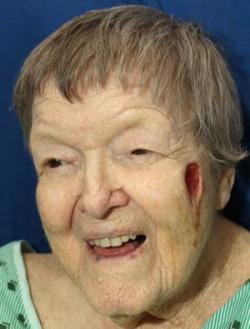Skin Cancer San Antonio
Skin cancer is one of the most common forms of cancer, and its incidence is quickly rising in the United States. It can affect the skin anywhere on the body, but the majority of cancers occur on the head, face, and neck; where it can be both disfiguring and dangerous. However with early detection, treatment can be curative and disfigurement can be minimized.
What are the causes of skin cancer? Who gets skin cancer?
The primary source of skin cancer is overexposure to ultraviolet radiation, typically from the sun or artificial sources such as sunlamps and tanning beds. The quest for the perfect sun-kissed tan, an increase in outdoor activities, and perhaps the thinning of the Earth’s protective ozone layer may be factors that contribute to the upsurge of reported skin cancers cases.
Skin cancer can affect anyone-no matter what the skin type, race, age, geographical location, occupation, and activity level. One is at an increased risk of developing the disease if…
- You have fair skin and freckle easily.
- You have blond hair and blue eyes.
- You have a large number of moles, or moles of unusual size or shape.
- You have a family history of skin cancer or a personal history of having sunburn as a child.
- You spend a lot of time working or playing outdoors.
- You live closer to the equator, at a higher altitude, or in any place that gets intense, year-round sunshine.
- You received therapeutic radiation treatments for adolescent acne.
Types of skin cancer
The most common skin cancer is basal cell carcinoma. Fortunately, it’s also the least dangerous skin cancer–it tends to grow slowly, and rarely spreads beyond its original site. Basal cell cancer is rarely life-threatening, however if left untreated it can grow deep beneath the skin and into the underlying tissue and bone, causing serious damage and disfigurement.
Squamous cell carcinoma is the second most common skin cancer, frequently appearing on the lips, face, or ears. It can spread to distant sites, including lymph nodes and internal organs. If it’s not treated squamous cell carcinoma can become life threatening.
The third most common form of skin cancer is also the most dangerous: melanoma. Its prevalence is increasing rapidly, most notably in the southern states. If diagnosed early enough, the disease can be cured. A delayed in its diagnosis may result in the cancer spreading throughout the body, which is often deadly.

Skin Procedures
Recognizing and diagnosing of skin cancer
Basal and squamous cell carcinomas may vary widely in appearance. These cancers often begin as: small, white, or pink nodules or bumps that are smooth, shiny, waxy, or pitted on the surface; a red and rough, dry, or scaly area of the skin; a firm, red lump that may form a crusted outer layer; a crusted group of nodules; a bleeding sore that does not heal after two to four weeks; or a white patch that resembles a scar.
Malignant melanoma may present as a “mole” that has undergone a change in size, shape, or color. Telltale signs of melanoma, or any skin cancer, are changes in the “ABCD” warning signs: Asymmetry- a skin growth that, if divided in half, both sides are uneven; Borders that are lumpy; Color- a mix of different colors with shades of tan, brown, and black, occasionally with hints of red, white, or blue; and Diameter- larger than 6 millimeters across (roughly the size of a standard pencil’s eraser) or any unusual size increase.
The most important thing a patient can do to help in the fight against skin cancer is to know their skin and examine it regularly, from the top of your head to the soles of your feet If you notice any unusual changes on any part of your body, have a doctor check it out.
Patients can take part in the fight against skin cancer by familiarizing themselves with their own skin and examine it in its entirety on a regular basis. If any unusual changes are noted on any part of the body, contact a physician immediately to schedule an examination.
If you’re concerned about skin cancer, a primary care physician is a good place to start. The doctor can examine your skin and either obtain a specimen for evaluation under the microscope, or refer you to a specialist.
Treatment
A skin cancer diagnosis comes after all or part of the area in question has been removed and its cells examined beneath a microscope. Depending on the form of cancer, its size, its location on the body, and whether or not it has spread, treatment may include a variety methods.
Most skin cancers are removed surgically. If the cancer is small, the procedure can be done quickly and easily, in an outpatient facility or the physician’s office, using local anesthesia. The procedure may be a simple removal, which usually leaves a thin, barely visible scar. Or curettage (scraping) and desiccation (drying out) may be performed. Both may leave a slightly larger white scar. In either case, the risks affiliated with each procedure are low.
However if the cancer is large, or if it has spread, major surgery may be required. Other options for treatments include cryosurgery (freezing the cancer cells), radiation therapy (using x-rays), topical chemotherapy (anti-cancer drugs applied to the skin), and Mohs surgery, a special procedure in which the cancer is shaved off one layer at a time. (Mohs surgery is performed only by specially trained physicians; it is not uncommon after Mohs surgery to require a reconstructive procedure).
For most basal cell and squamous cell cancers -and even for malignant melanoma, if it’s caught early, all of the treatments mentioned above, when chosen carefully, have good cure rates. Before beginning any treatment, all options and possible outcomes should be thoroughly discussed with a physician. It is imperative that factors taken into account when selecting a treatment option include effectiveness of the recommended treatment, possible risks and side effects of each treatment, and expected functional and cosmetic results. If doubts regarding the outcome exist, obtain a second opinion from a physician specializing in plastic and reconstructive surgery before beginning treatment.

Reconstruction of defects secondary to skin cancers
Many of the different techniques available for treating skin cancers are lifesaving, but they may leave a patient with less than pleasing cosmetic or functional results. Depending on the location and severity of the cancer, the consequences may range from a small but unsightly scar to permanent changes in facial structures such as your nose, ear, or lip, or on extremities it may cause functional consequences.
If you happen to have an unsightly scar or functional problem caused by scarring or the procedure itself, consult a board certified plastic & reconstructive surgeon to discuss possible solutions. Possible reconstructive options range from a simple scar revision to complicated procedures that involve transplanting layers of tissue from one area of the body to another.
As a board certified plastic & reconstructive surgeon Dr. Chattar-Cora with additional training in hand and microsurgery he has extensive experience treating many skin cancers, and if necessary reconstructing the deformities in an aesthetically pleasing and with minimal deformity.



